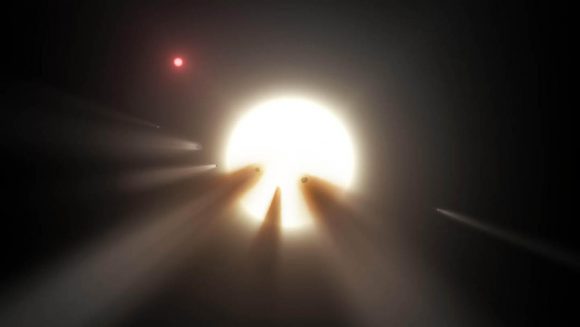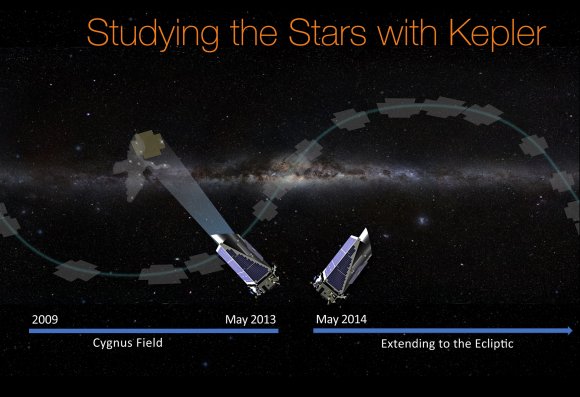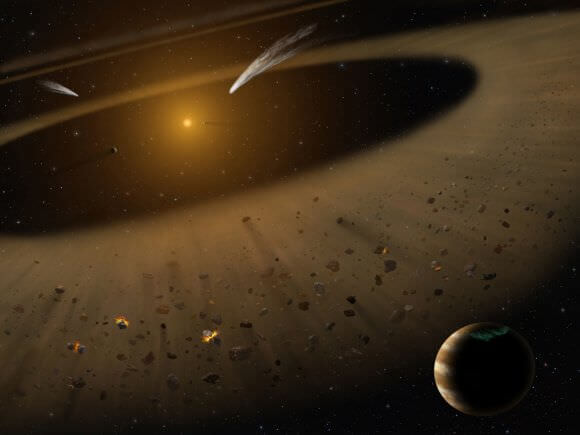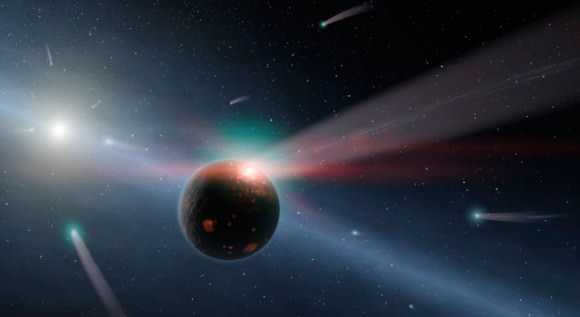In the past thirty years, thousands of extra-solar planets have been discovered beyond our Solar System. For the most part, they have been detected by the Kepler Space Telescope using a technique called Transit Photometry. For this method, astronomers measure periodic dips in a star's brightness - which are the result of planets passing in front of them relative to an observer - to confirm the presence of planets.
Thanks to a new research effort conducted by a team of professional and amateur astronomers, something much smaller than planets were recently detected orbiting a distant star. According to a new study published by the research team, six exocomets were observed orbiting around KIC 3542116, a spectral type F2V star located 800 light years from Earth. These comets are the smallest objects to date detecting the Transit Photometry method.
The study which details their findings, titled "Likely Transiting Exocomets Detected by Kepler", recently appeared in the Monthly Notices of the Royal Astronomical Society. Led by Saul Rappaport of MIT's Kavli Institute for Astrophysics and Space Research, the team also consisted of amateur astronomers, members of the Harvard-Smithsonian Center for Astrophysics (CfA), the University of Texas, Northeastern University, and NASA's Ames Research Center.

Artist's impression of an orbiting swarm of dusty comet fragments around Tabby's Star. Credit: NASA/JPL-Caltech
This is the first time that Transit Photometry has been used to detect object as small as comets. These comets were balls of ice and dust - comparable in size to Halley's Comet - that were found to be traveling at speeds of about 160,934 km/h (100,000 mph) before they vaporized. The researchers were able to detect them by picking out their tails, the clouds of dust and gas that form when comets get closer to their star and begin to sublimate.
This was no easy task, since the tails managed to obscure only about a tenth of 1% of the star's light. As Saul Rappaport, who is also the professor emeritus of physics at the Kavli Institute for Astrophysics and Space Research, explained in an MIT press release:
"It's amazing that something several orders of magnitude smaller than the Earth can be detected just by the fact that it's emitting a lot of debris. It's pretty impressive to be able to see something so small, so far away."
Credit for the original detection goes to Thomas Jacobs, an amateur astronomer who lives in Bellevue, Washington, and is a member of Planet Hunters. This citizen scientist project was first established by Yale University and consists of amateur astronomers who dedicated their time to the search for exoplanets. Members are given access to data from the Kepler Space Telescope in the hopes that they would notice things that computer algorithms might miss.

NASA's Kepler space telescope was the first agency mission capable of detecting Earth-size planets. Credit: NASA/Wendy Stenzel
Back in January, Jacobs began scanning four years of data obtained during Kepler's main mission. During this phase, which lasted from 2009 to 2013, Kepler scanned over 200,000 stars and conducted measurements of their light curves. After five months of sifting through the data (on March 18th), he noticed several curious light patterns amid background noise coming from KIC 3542116. As Jacobs said:
"Looking for objects of interest in the Kepler data requires patience, persistence, and perseverance. For me it is a form of treasure hunting, knowing that there is an interesting event waiting to be discovered. It is all about exploration and being on the hunt where few have traveled before."
Specifically, Jacobs was searching for signs of single transits, which are not like those that are caused by planets orbiting a star (i.e. periodic). While looking at KIC 3542116, he noticed three single transits, and then alerted Rappaport and Andrew Vanderburg, as astrophysicist at University of Texas and member of the CfA. Jacobs had worked with both men in the past, and wanted their opinion on these findings.
As Rapport recalled, the process of interpreting the data was challenging, but rewarding. Initially, they noted that the lightcurves did not resemble those caused by planetary transits, which are characterized by a sudden and sharp drop in light, followed by a sharp rise. In time, Rapport noted the asymmetry in the three lightcurves resembled those of disintegrated planets, which they had observed before.

Artist's impression of the Epsilon Eridani system, showing Epsilon Eridani b (a Jupiter-mass planet) and a series of asteroid belts and comets. Credit: NASA/SOFIA/Lynette Cook.
"We sat on this for a month, because we didn't know what it was — planet transits don't look like this," said Rappaport. "Then it occurred to me that, 'Hey, these look like something we've seen before'... We thought, the only kind of body that could do the same thing and not repeat is one that probably gets destroyed in the end. The only thing that fits the bill, and has a small enough mass to get destroyed, is a comet."
Based on their calculations, which indicated that each comet blocked out about one-tenth of 1% of the star's light, the research team concluded that the comet likely disintegrated entirely, creating a dust trail that was sufficient to block out light for several months before it disappeared. After conducting additional observations, they also noted three more transits in the same time period that were similar to the ones noticed by Jacobs.
The fact that these six exocomets appear to have transited very close to their star in the past four years raises some interesting questions, and answering them could have drastic implications for extra-solar research. It could also advance our understanding of our own Solar System. As Vanderburg explained:
"Why are there so many comets in the inner parts of these solar systems? Is this an extreme bombardment era in these systems? That was a really important part of our own solar system formation and may have brought water to Earth. Maybe studying exocomets and figuring out why they are found around this type of star… could give us some insight into how bombardment happens in other solar systems."

This artist's conception illustrates a storm of comets around a star near our own. Credit: NASA/JPL-Caltech
Between 4.1 and 3.8 billion years ago, the Solar System also experienced a period of intense comet activity known as the Late Heavy Bombardment. During this time, asteroids and comets are believed to have impacted bodies in the inner Solar System on a regular basis. Interestingly, this period of heavy bombardment is believed to be what was responsible for the distribution of water to Earth and the other terrestrial planets.
As noted, KIC 3542116 belongs to the spectral type F2V, a yellow-white class of star that is typically 1 to 1.4 times as massive as our Sun and quite bright. Since it is comparable in size and mass to our Sun, it is possible that the bombardment period it is experiencing is similar to what the Solar System went through. Watching it unfold could therefore tell us much about how similar activity influenced the evolution of our Solar System billions of years ago.
In addition to the study's significance to the study of astrophysics and astronomy, it also demonstrates the important role citizen scientists play today. Were it not for the tireless work performed by Jacobs, who sifts through Kepler data between working his day job and on the weekends, this discovery would not have been possible.
"I could name 10 types of things these people have found in the Kepler data that algorithms could not find, because of the pattern-recognition capability in the human eye," said Rappaport. "You could now write a computer algorithm to find this kind of comet shape. But they were missed in earlier searches. They were deep enough but didn't have the right shape that was programmed into algorithms. I think it's fair to say this would never have been found by any algorithm."
In the future, the research team expects that the deployment Transiting Exoplanet Survey Satellite (TESS) - which will be led by MIT - will continue to conduct the type of research performed by Kepler.
Further Reading: MIT, MNRAS
No comments:
Post a Comment